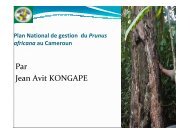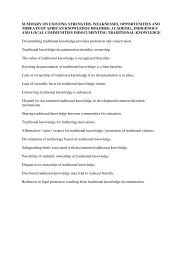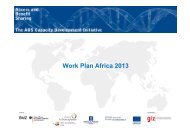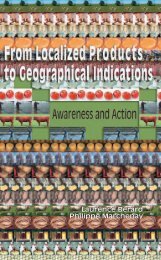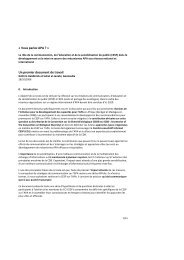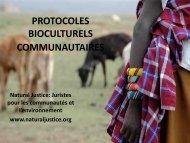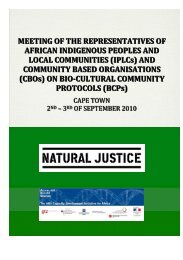The History of Farmers' Rights - Fridtjof Nansens Institutt
The History of Farmers' Rights - Fridtjof Nansens Institutt
The History of Farmers' Rights - Fridtjof Nansens Institutt
You also want an ePaper? Increase the reach of your titles
YUMPU automatically turns print PDFs into web optimized ePapers that Google loves.
30 Regine Andersen<br />
resources and as a basis for farmers’ rights. Brush starts out with an analysis<br />
<strong>of</strong> the nature <strong>of</strong> the ‘common heritage’ regime that was a prevalent<br />
feature <strong>of</strong> the management <strong>of</strong> crop genetic resources until the adoption <strong>of</strong><br />
the CBD. In this context he explains key characteristics <strong>of</strong> traditional<br />
agricultural knowledge and the background to the closing <strong>of</strong> the genetic<br />
commons by the upcoming intellectual property rights regimes under the<br />
World Trade Organization and by the access and benefit sharing regime<br />
under the CBD. He <strong>of</strong>fers examples <strong>of</strong> domestic implementation <strong>of</strong> these<br />
regimes from Colombia, Mexico and Costa Rica, all showing the negative<br />
effects <strong>of</strong> such regimes for the management <strong>of</strong> crop genetic resources.<br />
An important reason for these problems is that the access and benefit<br />
sharing regimes derived from the CBD failed to distinguish between wild<br />
and domesticated plant genetic resources. According to Brush, there are<br />
three important differences (pp. 21[A]/80[B]): ‘(1) involvement <strong>of</strong> numerous<br />
farmers and farming communities in creating and maintaining<br />
genetic resources, (2) genetic complexity <strong>of</strong> crop traits, and (3) a long<br />
history <strong>of</strong> exchange and publicly supported conservation <strong>of</strong> crop genes<br />
within and outside <strong>of</strong> their places <strong>of</strong> origin.’ Crop genetic resources<br />
should be approached in a fundamentally different way, reviving the<br />
‘common heritage’ approach.<br />
On this background, Brush analyses the International Treaty. He concludes<br />
that the ‘common heritage’ principle has re-emerged in the Treaty,<br />
with its Multilateral System <strong>of</strong> Access and Benefit Sharing. This is the<br />
context in which the provisions <strong>of</strong> the International Treaty on farmers’<br />
rights are explored. Bioprospecting contracts between farming communities<br />
and seed companies would not only be legally difficult, but could<br />
also lead to market failure because a multitude <strong>of</strong> farmers would face an<br />
extremely limited set <strong>of</strong> potential ‘buyers’ <strong>of</strong> their genetic resources. For<br />
this and other reasons, alternative approaches to the realization <strong>of</strong> farmers’<br />
rights need to be found. Brush suggests four guidelines for the crafting<br />
<strong>of</strong> national policies (pp. 29[A]/93[B]): (1) the goals <strong>of</strong> farmers’ rights<br />
should balance breeders’ rights and encourage farmers to continue as<br />
stewards and providers <strong>of</strong> crop genetic resources; (2) farmers’ rights<br />
should be viewed as collective rights rather than rights <strong>of</strong> individual<br />
farmers or communities; (3) farmers’ rights should not be exclusive and<br />
are not meant to limit access to genetic resources; and (4) mechanisms<br />
are needed for sharing the benefits received by the international community<br />
from the genetic material from farmers’ fields or international<br />
collections.<br />
According to Brush, the weakness <strong>of</strong> the International Treaty is that it<br />
does not give proper emphasis to the obligations <strong>of</strong> industrial and developing<br />
countries to support the conservation <strong>of</strong> crop genetic resources.<br />
<strong>The</strong>refore, it does not solve Hardin’s classic ‘tragedy <strong>of</strong> the commons’ 32<br />
that has beset the management <strong>of</strong> crop genetic resources, allowing breeders<br />
to benefit from the access to genetic resources without bearing the<br />
32 Hardin, Garrett (1968): ‘<strong>The</strong> Tragedy <strong>of</strong> the Commons’, Science, 162, pp.<br />
1243–1248





